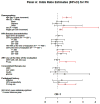Peripheral neuropathy in ART-experienced patients: prevalence and risk factors
- PMID: 24297499
- PMCID: PMC3965352
- DOI: 10.1007/s13365-013-0216-4
Peripheral neuropathy in ART-experienced patients: prevalence and risk factors
Abstract
Peripheral neuropathy (PN) is a common neurological complication of HIV infection that has debilitating effects on quality of life. While there has been a comprehensive evaluation of the prevalence of neuropathic signs/symptoms and risk factors (RFs) for PN or symptomatic PN (SPN) with initiation of combination antiretroviral therapy (cART) in ART-naïve patients, similar evaluation in ART-experienced patients is limited. This study investigated the prevalence and RFs for PN/SPN in ART-experienced patients enrolled in clinical salvage therapy studies. Between February 2000 and June 2007, 522 ART-experienced participants who experienced virologic failure with a prior regimen and started new regimens were followed longitudinally and annually screened for signs and symptoms of PN. Rates of PN/SPN at 3 years since parent study entry were 52.8 and 24.0 %, respectively. Aging, taller height, protease inhibitor use, and female sex were significant RFs for PN/SPN. The use of statin drugs was significantly associated with lower odds of SPN, and it may prevent progression from no SPN to SPN.
Conflict of interest statement
Scott R. Evans has grant funding from NIH. The other authors declare that they have no conflict of interest.
Figures
References
-
- Keswani SC, Pardo CA, Cherry CL, Hoke A, McArthur JC. HIV-associated sensory neuropathies. AIDS. 2002;16:2105–2117. - PubMed
-
- Bacellar H, Munoz A, Miller EN, Cohen BA, Besley D, Selnes OA, Becker JT, McArthur JC. Temporal trends in the incidence of HIV-1-related neurologic diseases: Multicenter AIDS Cohort Study, 1985–1992. Neurology. 1994;44:1892–1900. - PubMed
-
- McArthur JC, Brew BJ, Nath A. Neurological complications of HIV infection. Lancet Neurol. 2005;4:543–555. - PubMed
Publication types
MeSH terms
Substances
Grants and funding
LinkOut - more resources
Full Text Sources
Other Literature Sources
Medical



